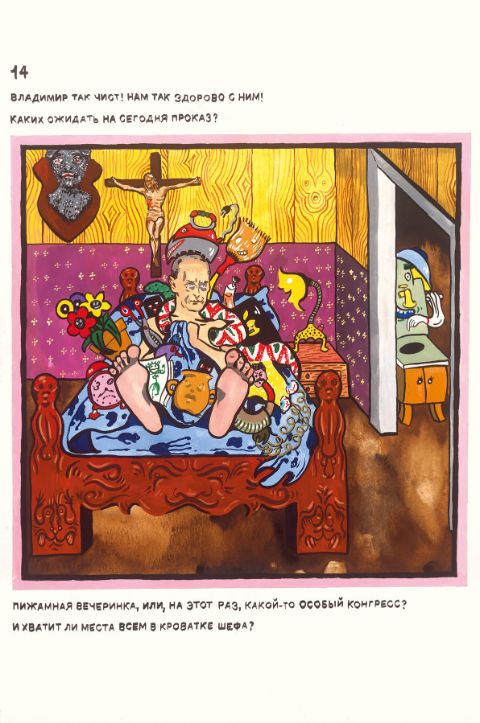Roee Rosen

Roee Rosen, Maxim Komar-Myshkin, Vladimir’s Night (2013/2025). Courtesy of Roee Rosen
In his literary and visually dense video works, drawings, publications, and installations, Roee Rosen creates characters, traces the lives of fictional artists, works with alter egos, and engages in controversial games of confusion with twentieth-century history and the pitfalls of contemporary politics and society. Rosen reflects relentlessly on his own position in relation to how the present is narrated and with what motifs when he approaches these themes artistically and narratively. The resulting distorted images and free spaces serve as an experimental arena for playing through possible life courses and timelines: We often become aware of Rosen’s own abysses, fascinations, obsessions, but also fears of illness and death, which he skilfully and artfully weaves in the lives of those he creates. Maxim Komar-Myshkin, a character artistically brought back to life by Rosen, is a Russian dissident, artist, and emigrant. Haunted by the certainty that he would be murdered on Vladimir Putin’s orders, Myshkin took his own life in 2011. Among his personal belongings in his apartment, Vladimir’s Night was discovered—an album of verses and drawings in which the Russian president is repeatedly tortured with objects and ultimately killed. Annotations reveal the entire conspiracy cosmos of Russian history and, at the same time, Komar-Myshkin’s artistic revenge on Putin. Out (‘TSE’) (2010) begins with a quasi-documentary BDSM and interview scene that turns out to be the prelude to an exorcism in which the submissive person responds to the dominatrix not with cries of pain but with confessions in complete sentences, with a distorted voice, and with quotations from Avigdor Liebermann, a far-right-wing politician who was Israel’s foreign minister at the time the film was made. The last musical scene of the film is a song based on the words of Russian poet Sergei Yesenin from his letter to his mother.
The Gaza War Tattoos (2024–25) is Rosen’s latest series of works. The cultural history of tattoos is complex and varied—ranging from jewellery and markings to acts of rebellion. With his series, Rosen explores these meanings in the context of the ongoing atrocious war. The Dreadful Dreidel is composed exclusively from the names given by the Israeli army to its military violence during the current century. The vast majority of these names have an eerily pastoral nature, some use the crass grandeur of biblical awe, and some newspeak reversals, two names hark back to children's rhymes. An investigative report by The New York Times from October 2024, describing the name ‘mosquito procedure’ or ‘wasp procedure’ for using civilians as human shields, is referenced in the tattoos. While the first series of images from 2024 were emulations of tattoos created with makeup, stickers, and image editing, the second series from 2025 consists of real tattoos: disturbing, cruel, and of a truly piercing clarity.
Works in the exhibition: The Gaza War Tattoos (2024–25), series of photographs, dimensions variable. 2025 edition: Night Skies with Full Moons (A Witness); Night Skies Crescent Moons (Evidence); Safe Zone, Arabic; Safe Zone, English; Safe Zone, Hebrew; The Dreadful Dreidel, a Military Historical Poem; The Dreadful Dreidel, a Military Historical Poem, Hebrew; Burning IV; Burning Book; Total Victory, Hebrew; Total Victory, English; Total Victory, Arabic; A Tunnel; Listening; A Landscape with a bed; Mosquito Procedure; Wasp Procedure; Crying Skulls I (“forked Tongue,” Nape); Crying Skulls II (“Grimace,” belly); Crying Skulls III (“Foolish Virgin,” wrist); Crying Skulls IV (“Aghast,” hand); A Hidden Tunnel. The Gaza War Tattoos (2025 edition) commissioned by Haus der Kulturen der Welt (HKW), co-produced by Roee Rosen and HKW, 2025; OUT (‘TSE’) (2010), 1-channel video, colour, sound, 34'; Roee Rosen, Maxim Komar-Myshkin, Vladimir’s Night (2013/25), slide show of gouaches on paper, dimensions variable. Courtesy of the artist. With the kind support of Artis